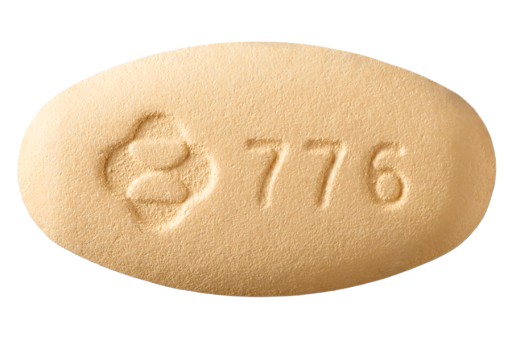Delstrigo
100 mg doravirine, 300 mg lamivudine, 300 mg tenofovir DF DOR (NNRTI), 3TC and TDF (two NRTIs)

Standard Dose
One tablet once daily, with or without food, for adults and pediatric patients weighing at least 77 pounds (35 kg) taking HIV treatment for the first time (treatment-naïve) or individuals with suppressed viral load on a stable HIV regimen for at least 6 months who have no known resistance to components of the regimen: doravirine, lamivudine, or tenofovir.Take missed dose as soon as possible, unless it is closer to the time of your next dose. Do not double up on your next dose. Dose cannot be adjusted for people with kidney problems; Delstrigo is not recommended for people with estimated creatinine clearance less than 50 mL/min. Should not be used by people with moderate or severe kidney impairment or severe liver impairment.
- See the individual drugs contained in Delstrigo: Pifeltro, Epivir, and Viread.
- See package insert for more complete information on potential side effects and interactions.
Manufacturer
Merck & Co.delstrigo.com
(800) 672-6372
AWP
$2,552.40/monthPotential Side Effects and Toxicity
The most common adverse reactions observed with Delstrigo in clinical trials were dizziness (7%), nausea (5%), abnormal dreams (5%), and headache (4%). Neuropsychiatric events—such as depression, sleep disturbances, dizziness, etc.—are another common side effect of the NNRTI drug class. The proportion of people who reported one or more neuropsychiatric adverse events overall was 24% for the Delstrigo group compared to 57% for the Atripla group in the DRIVE-AHEAD study.
Neuropsychiatric adverse events associated with depression and suicide/self-injury were reported in 4% of the Delstrigo group compared to 7% of the Atripla group. Overall, sleep disturbances (abnormal dreams, insomnia, nightmares, etc.) were associated with 12% of people in the Delstrigo group compared to 26% of people in the Atripla group. Dizziness was experienced by 9% of the Delstrigo group compared to 37% of the Atripla group. Altered sensorium (lethargy, drowsiness, etc.) was associated with 4% of people in the Delstrigo group compared to 8% of those on Atripla. The doravirine component of Delstrigo did not appear to negatively affect cholesterol in studied populations. Decreases in bone mineral density (BMD) have been observed in people on TDF-containing regimens. BMD monitoring should be considered for people who have a history of bone fracture due to bone disease or are at risk for osteopenia or osteoporosis. TDF may cause kidney toxicities. Creatinine clearance (CrCl) should be assessed before initiating treatment. In addition to CrCl, glucose and protein in the urine and serum phosphorus should be monitored more often in people at risk for kidney problems. Tell your provider about any pain in extremities, persistent or worsening bone pain and fractures, with or without muscular pain or weakness, as well as any concerning changes in urinary habits, as these could be signs of kidney problems. Prior to initiation, people should be tested for hepatitis B virus (HBV) infection.
Severe exacerbations of hepatitis B have been reported in people co-infected with HBV who have discontinued Delstrigo (due to elimination of the lamivudine and TDF components, which also treat HBV). Monitor liver enzymes closely in people co-infected with HBV and, if appropriate, initiation of anti-hepatitis B therapy may be warranted upon Delstrigo discontinuation. Call your health care provider right away if you develop any of the following signs or symptoms of hepatitis: yellowing of the skin or whites of the eyes; dark or tea-colored urine; pale-colored bowel movements; nausea or vomiting; loss of appetite; or pain, aching, or tenderness on the right side below the ribs.
Potential Drug Interactions
Do not take with Cimduo or Temixys, Descovy, Emtriva, Epivir-HBV, Hepsera, Truvada, Vemlidy, or Viread, all used for hepatitis B. When using with the antibiotic drug rifabutin (used for TB and to prevent MAC in people with AIDS), increase the doravirine dose by taking Pifeltro 100 mg tablet approximately 12 hours after Delstrigo. Avoid taking Delstrigo with drugs that negatively affect the kidneys, including chronic use or high doses of anti-inflammatory drugs for pain such as Advil or Motrin (ibuprofen) and Aleve (naproxen).
The following medications may lower the blood levels of doravirine, and therefore may decrease its effectiveness, and should not be used with Delstrigo: the anticonvulsants carbamazepine, oxcarbazepine, phenobarbital, and phenytoin; the androgen receptor inhibitor enzalutamide; the antimycobacterials rifampin and rifapentine; the cytotoxic agent (a cancer drug) mitotane; and the herbal St. John’s wort. Avoid using sorbitol-containing medicines with lamivudine; there are many, such as acetaminophen liquid (Tylenol liquid and others). Epclusa and Harvoni each increase the concentration of TDF; monitor for adverse reactions. Not intended to be taken with other HIV medications, unless prescribed that way. Tell your provider or pharmacist about all medications, herbals, and supplements you are taking or thinking of taking, prescribed or not, as there are other drug interactions that are not listed here.
More Information
Standalone versions of doravirine (Pifeltro) and lamivudine/tenofovir DF (Cimduo, Temixys) are also approved; see those pages. Delstrigo contains an older prodrug of tenofovir, TDF. A safer version, TAF, is available and used in some STRs. However, as TAF and INSTIs may have some association with weight gain, Delstrigo may become a more popular option. According to HHS guidelines, “In a cross-trial analysis, DOR was not associated with weight gain compared with [efavirenz] 600 mg or boosted [darunavir].” TDF is still an effective and quite tolerable medication, but TAF has potentially less long-term renal and bone toxicity. Doravirine has not been directly compared to integrase inhibitor-based regimens in clinical trials yet.
In the DRIVE-FORWARD study comparing doravirine to darunavir, at 96 weeks, 72% of treatment-naïve individuals in the doravirine group attained undetectable status (a viral load of less than 50 copies/mL), compared to 65% for the darunavir group. For individuals with HIV-2, commonly found outside the U.S., an NNRTI would not be recommended as HIV-2 is inherently resistant to NNRTIs. There are no data on the safe use of Delstrigo during pregnancy. Pregnant individuals can voluntarily enroll in the Antiretroviral Pregnancy Registry through their provider; GO TO apregistry.com.
Doctor Comments
Dr. Melanie Thompson:
Delstrigo is approved for initial therapy, based on clinical trials comparing it to efavirenz or ritonavir-boosted darunavir, but it is not recommended for initial therapy in most people with HIV in the U.S. because it has never been compared directly to an INSTI-containing regimen. (The European guidelines, however, have elevated Delstrigo to be used in initial therapy.) Doravirine had fewer neuropsychiatric side effects than efavirenz in the DRIVE-AHEAD trial, and less diarrhea and nausea than ritonavir-boosted darunavir in DRIVE-FORWARD. Lipid changes were lower with the doravirine regimen in both trials. Kidney and bone density effects of TDF are key considerations in terms of side effects (SEE Viread). In a cross-study analysis, mean weight gain with doravirine (1.7 kg) was more than with efavirenz (0.6 kg) and similar to ritonavir-boosted darunavir (1.4 kg) at 48 weeks, but all were similar at week 96. Delstrigo is not recommended in pregnancy due to insufficient data on doravirine.
Doravirine has fewer drug-drug interactions than either efavirenz or rilpivirine, but levels can be decreased by some seizure or tuberculosis medicines, St. John’s wort, and enzalutamide, an androgen blocker. Initial hopes that doravirine might be genetically more robust and less likely to select for drug resistance, however, have been met with disappointment. With two generic drugs, you would expect Delstrigo’s average wholesale cost to be lower than it is.
Activist Comments
Activist Joey Wynn:
This is one of the first viable older combinations in a “new generic formulation.” Pricing is great, but an older regimen with a few negatives makes this a second-line option. I believe doravirine has a better resistance profile than others in the NNRTI class, as well as an attractive lipid profile; in light of this it could be an option for people concerned about cardiovascular issues.


